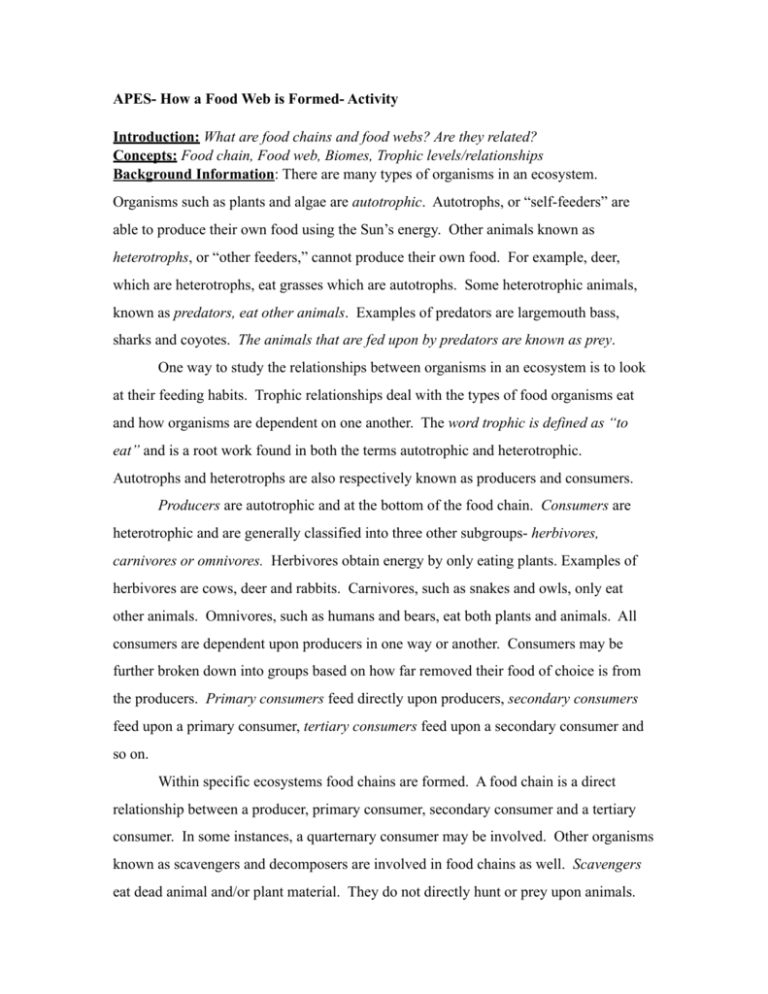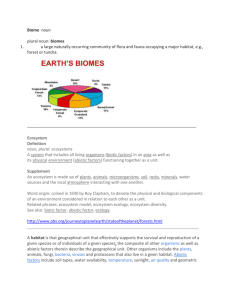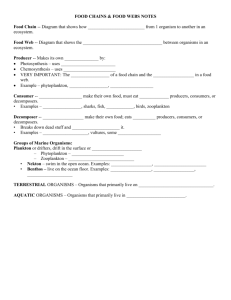APES- How a Food Web is Formed- Activity Introduction: What are
advertisement

APES- How a Food Web is Formed- Activity Introduction: What are food chains and food webs? Are they related? Concepts: Food chain, Food web, Biomes, Trophic levels/relationships Background Information: There are many types of organisms in an ecosystem. Organisms such as plants and algae are autotrophic. Autotrophs, or “self-feeders” are able to produce their own food using the Sun’s energy. Other animals known as heterotrophs, or “other feeders,” cannot produce their own food. For example, deer, which are heterotrophs, eat grasses which are autotrophs. Some heterotrophic animals, known as predators, eat other animals. Examples of predators are largemouth bass, sharks and coyotes. The animals that are fed upon by predators are known as prey. One way to study the relationships between organisms in an ecosystem is to look at their feeding habits. Trophic relationships deal with the types of food organisms eat and how organisms are dependent on one another. The word trophic is defined as “to eat” and is a root work found in both the terms autotrophic and heterotrophic. Autotrophs and heterotrophs are also respectively known as producers and consumers. Producers are autotrophic and at the bottom of the food chain. Consumers are heterotrophic and are generally classified into three other subgroups- herbivores, carnivores or omnivores. Herbivores obtain energy by only eating plants. Examples of herbivores are cows, deer and rabbits. Carnivores, such as snakes and owls, only eat other animals. Omnivores, such as humans and bears, eat both plants and animals. All consumers are dependent upon producers in one way or another. Consumers may be further broken down into groups based on how far removed their food of choice is from the producers. Primary consumers feed directly upon producers, secondary consumers feed upon a primary consumer, tertiary consumers feed upon a secondary consumer and so on. Within specific ecosystems food chains are formed. A food chain is a direct relationship between a producer, primary consumer, secondary consumer and a tertiary consumer. In some instances, a quarternary consumer may be involved. Other organisms known as scavengers and decomposers are involved in food chains as well. Scavengers eat dead animal and/or plant material. They do not directly hunt or prey upon animals. Turkey vultures are classic scavengers. Decomposers are organisms that break down tissues of living or non-living organisms. Decomposers absorb nutrients from organisms they feed upon. Fungi and bacteria are good examples of this group. In nature, not all feeding relationships between organisms are formed directly in a food chain. There are many individuals that may prey or be preyed upon by different types of organisms. A food web more accurately defines these types of relationships. Food webs are networks of complex interactions formed by the feeding relationships among the various organisms in an ecosystem. The number and types of producers and consumers in an ecosystem depend on the region where the ecosystem exists. Earth is divided into several different areas known as biomes. Biomes are defined by the types of animals, flowers, and climate they contain. In general, there are five main biomes- aquatic, desert, forest, grassland, and tundra. Biomes are further divided into different habitats or areas where an organism naturally lives. Experiment Overview: In this activity, organisms from five different habitats- marine, desert, tropical rainforest, hardwood forest, and swamp- will be studied. Food chains and webs will be formed for each of these habitats. Procedure: 1) Students form small groups of 3-4 students each 2) Obtain one of the habitat card sets from the instructor. Each person should also obtain the appropriate Food Web Sheet that matches the habitat you have chosen. 3) Pick one member of the group to be the dealer 4) Deal five cards to each person in the group 5) Place the remaining cards face down on the table top 6) The person to the left of the dealer should draw a card from the top of the pile 7) The card should be placed in the first person’s hand 8) The object of the game is to complete a food chain containing five organisms 9) Use the appropriate Food Web Sheet to confirm whether or not a food chain of five organisms has been formed 10) If a complete food chain of five organisms is not in the first person’s hand one of the first person’s cards must be discarded face-down next to the original draw pile. 11) The next player to the left may either pick up a card from the draw pile or the discard pile 12) Play continues clockwise until a food chain is formed 13) If cards run out in the draw pile reshuffle the discard pile and use that as the new draw pile 14) Resume play until all members of the group create a complete food chain 15) When all food chains are complete, the 1st player to complete his/her food chain must place them all on the table. Using the string provided, make connections in the food chain. 16) One by one, each player must add his/her food chain to the food web in the appropriate places and add the connections. 17) Once all of the players have placed their cards on the table- Draw the food web on a large piece of poster paper with the correct descriptions and connections. Make sure to label all parts and nature the habitat. 18) If time allows, share out to the group. 19) Draw the food web in your notebook and answer the post lab questions. Post Lab Questions: 1) What is a trophic level? 2) Are most habitats better described as a food chain or a food web? Why? 3) What roles do decomposers and scavengers play in a habitat? What would happen if these organisms were not present? 4) What would happen if a predator organism was removed from a certain habitat? Use specific examples from your group’s constructed food web. 5) Can an organism be a secondary and tertiary consumer in the same ecosystem? Explain using examples from the game. 6) In general, are there more tertiary consumers or producers in a healthy habitat? Why? 7) Summarized (in 1-2 paragraphs) what you learned during this activity- use specific vocabulary and details from the activity.








